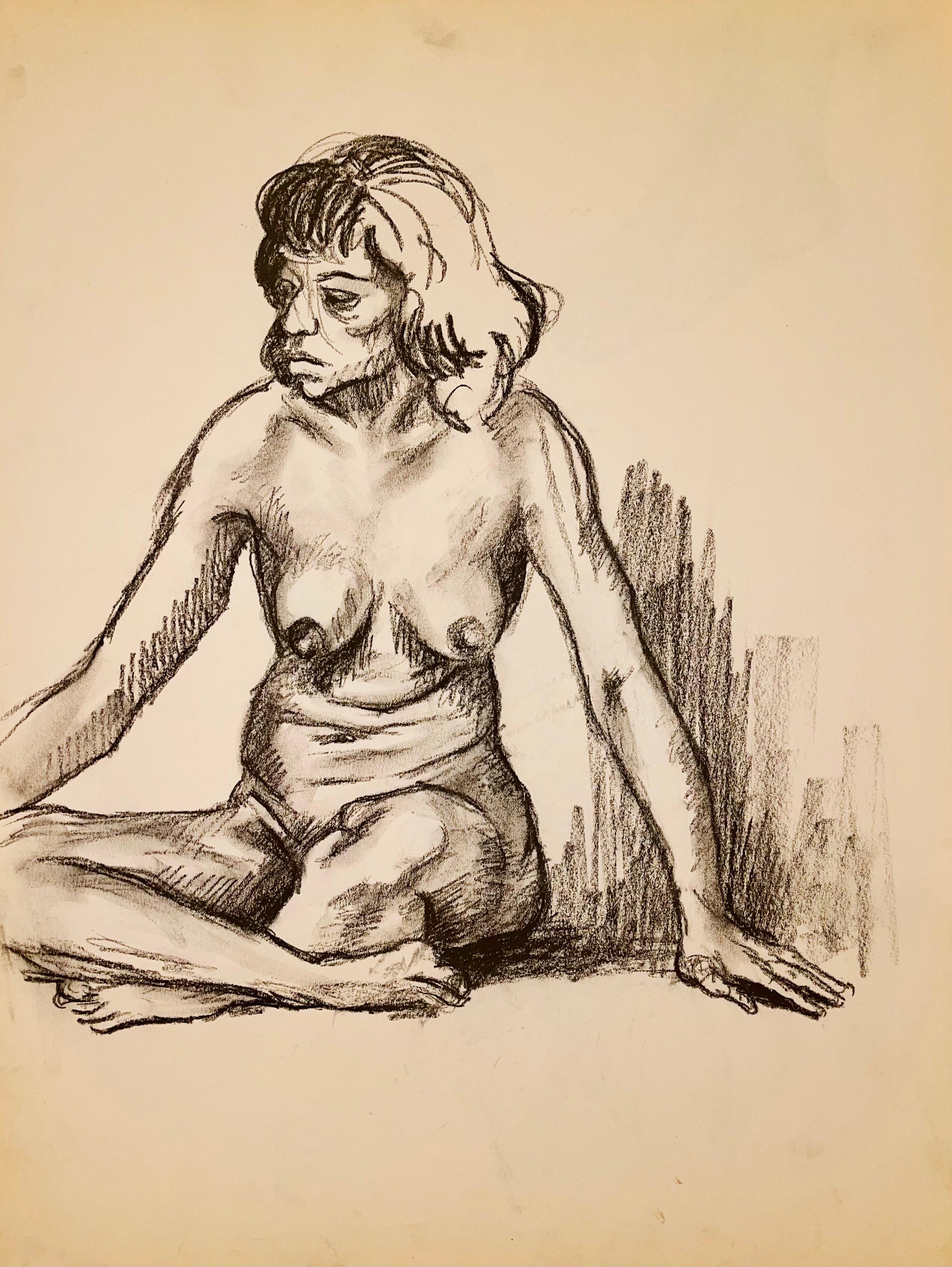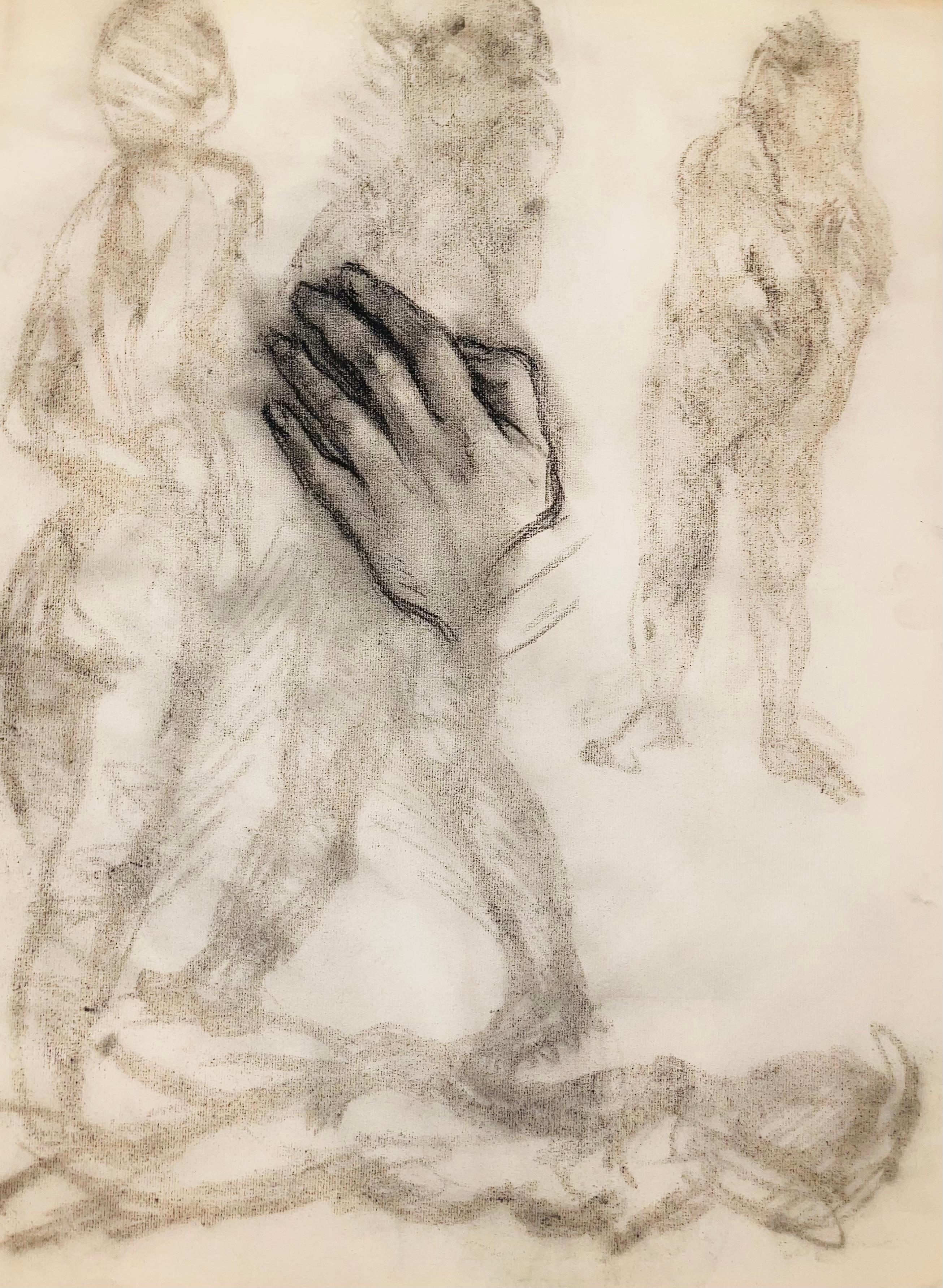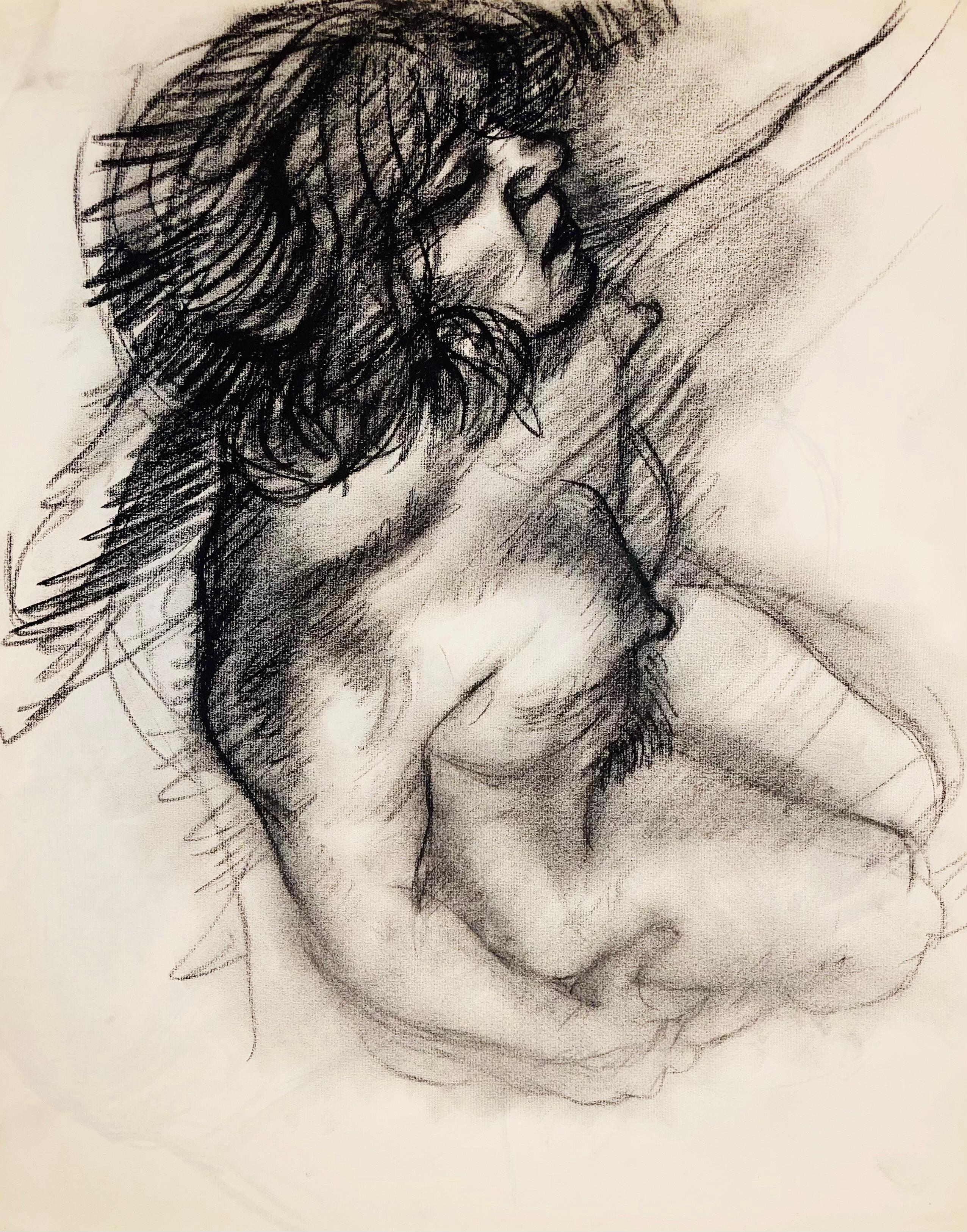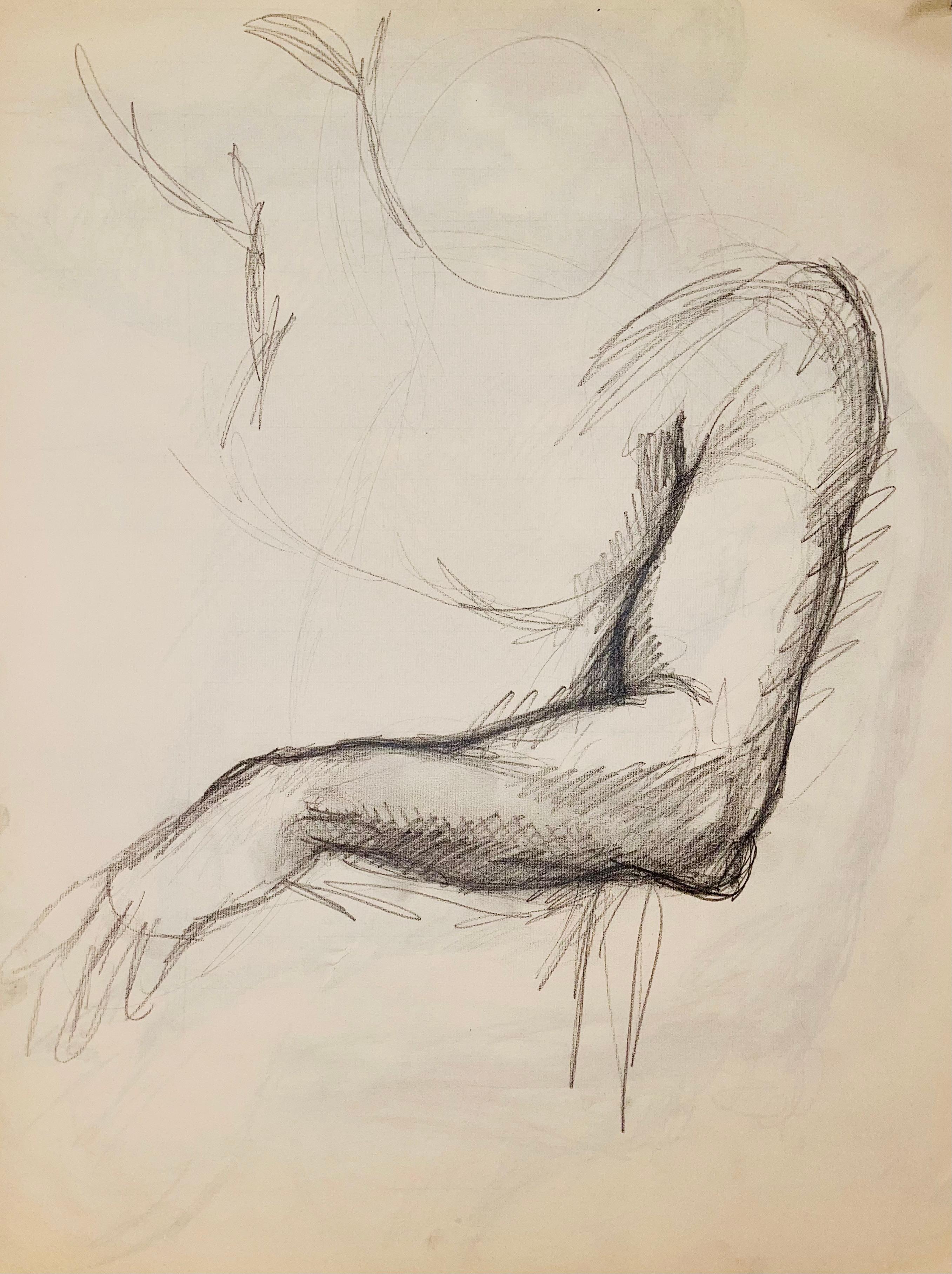Items Similar to The Captive, Study of a Naked Youth, Red Chalk Study, Carracci Gallery
Want more images or videos?
Request additional images or videos from the seller
1 of 2
The Captive, Study of a Naked Youth, Red Chalk Study, Carracci Gallery
About the Item
Red chalk on paper
Image size: 5 x 8 1/2 inches (12.75 x 21.5 cm)
Mounted
This 18th century drawing is after the work of the 16th Century Italian artist Annibale Carraci. This figure, along with many more, were painted by Carraci in the Palazzo Farnese in a space now known as the Carracci gallery. The Carracci gallery is considered as one of the most important Renaissance commissions in Rome. This figure, along with five other companions, were known as 'The Captives'. They were designed by the artist to appear trapped in the architectural spaces in the walls and sat around the fresco that featured Perseus and Andromeda.
Similarly to the original drawings, this artist has taken considerable care to sculpt his form with light and shadow, gently blending strokes on the smooth-skinned cheek and distinctly denoting the direction of hair strands.
Annibale Carracci
Annibale Carracci (1560–1609) was the most admired painter of his time and the vital force in the creation of Baroque style. Together with his cousin Ludovico (1555–1619) and his older brother Agostino (1557–1602)—each an outstanding artist—Annibale set out to transform Italian painting. The Carracci rejected the artificiality of Mannerist painting, championing a return to nature coupled with the study of the great northern Italian painters of the Renaissance, especially Correggio, Titian, and Veronese.
During the 1580s, the Carracci were painting the most radical and innovative pictures in Europe. Annibale not only drew from nature, he created a new, broken brushwork to capture movement and the effects of light on form. His Two Children Teasing a Cat marks a new chapter in the history of genre painting. The revolutionary potential of this new kind of painting would be taken up over a decade later by Caravaggio, who must have seen the Carraccis’ work while traveling from Milan to Rome in 1592.
The Carracci saw themselves as heir to a great artistic tradition, and they consciously situated themselves within the history of northern Italian painting. Annibale and Agostino visited Parma and Venice to study the work of Correggio, Titian, Tintoretto, and Veronese. Their altarpieces and secular fresco cycles in Bologna reasserted a northern Italian emphasis on color, light, and the study of nature, but with a new focus on emotive communication. Their success led to Annibale being invited to Rome to work for the powerful Farnese family (1595). Ludovico remained in Bologna to direct the academy they founded. Through the next generation of painters—Francesco Albani, Domenichino, Guido Reni, Giovanni Lanfranco, and Guercino—Bolognese painting became the dominant force in seventeenth-century art.
In Rome, Annibale’s painting was transformed through his first-hand encounter with classical antiquity and the art of Michelangelo and Raphael. Individual scenes of ancient mythology are surrounded by an elaborate illusionistic framework with feigned statues, in front of which sit muscular nude figures seemingly lit from the actual windows (Galleria Farnese ceiling). The corners are opened to painted views of the sky. When unveiled in 1600, the ceiling was instantly acclaimed as the equal of any work in the past. In combining northern Italian naturalism with the idealism of Roman painting, Annibale created the basis of Baroque art. His only challenger in Rome was Caravaggio, whose relation with the past was combative rather than assimilative. Moreover, Caravaggio’s art was unsuited to large compositions and fresco cycles, and by 1630 Caravaggesque painting was in decline while Annibale’s art was being studied by a new generation of artists. Rubens, Poussin, and Bernini were deeply indebted to him.
- Dimensions:Height: 8.5 in (21.59 cm)Width: 5 in (12.7 cm)
- More Editions & Sizes:1 of 2Price: $841
- Medium:
- Movement & Style:
- After:Annibale Carracci (1560 - 1609, Italian)
- Period:
- Framing:Framing Options Available
- Condition:
- Gallery Location:London, GB
- Reference Number:1stDibs: LU52413384992
About the Seller
5.0
Vetted Seller
These experienced sellers undergo a comprehensive evaluation by our team of in-house experts.
Established in 2007
1stDibs seller since 2014
63 sales on 1stDibs
Typical response time: 4 hours
- ShippingRetrieving quote...Ships From: London, United Kingdom
- Return PolicyA return for this item may be initiated within 14 days of delivery.
More From This SellerView All
- The Captive, Study of a Naked Man, Red Chalk Study, Carracci GalleryBy Annibale CarracciLocated in London, GBRed chalk on paper Image size: 11 x 5 1/2 inches (28 x 14 cm) Mounted This 18th century drawing is after the work of the 16th Century Italian artist Annibale Carraci. This figure, along with many more, were painted by Carraci in the Palazzo Farnese in a space now known as the Carracci gallery. The Carracci gallery is considered as one of the most important Renaissance commissions in Rome. This figure, along with five other companions, were known as 'The Captives'. They were designed by the artist to appear trapped in the architectural spaces in the walls and sat around the fresco that featured Perseus and Andromeda. Annibale Carracci Annibale Carracci (1560–1609) was the most admired painter of his time and the vital force in the creation of Baroque style. Together with his cousin Ludovico (1555–1619) and his older brother Agostino (1557–1602)—each an outstanding artist—Annibale set out to transform Italian painting. The Carracci rejected the artificiality of Mannerist painting, championing a return to nature coupled with the study of the great northern Italian painters of the Renaissance, especially Correggio, Titian, and Veronese.During the 1580s, the Carracci were painting the most radical and innovative pictures in Europe. Annibale not only drew from nature, he created a new, broken brushwork to capture movement and the effects of light on form. His Two Children Teasing a Cat marks a new chapter in the history of genre painting. The revolutionary potential of this new kind of painting would be taken up over a decade later by Caravaggio, who must have seen the Carraccis’ work while traveling from Milan to Rome in 1592.The Carracci saw themselves as heir to a great artistic tradition, and they consciously situated themselves within the history of northern Italian painting. Annibale and Agostino visited Parma and Venice to study the work of Correggio, Titian, Tintoretto, and Veronese. Their altarpieces and secular fresco cycles in Bologna reasserted a northern Italian emphasis on color, light, and the study of nature, but with a new focus on emotive communication. Their success led to Annibale being invited to Rome to work for the powerful Farnese family (1595). Ludovico remained in Bologna to direct the academy they founded. Through the next generation of painters—Francesco Albani, Domenichino, Guido Reni, Giovanni Lanfranco, and Guercino—Bolognese painting became the dominant force in seventeenth-century art. In Rome, Annibale’s painting was transformed through his first-hand encounter with classical antiquity and the art of Michelangelo and Raphael. Individual scenes of ancient mythology are surrounded by an elaborate illusionistic framework with feigned statues, in front of which sit muscular nude figures seemingly lit from the actual windows (Galleria Farnese ceiling). The corners are opened to painted views of the sky. When unveiled in 1600, the ceiling was instantly acclaimed as the equal of any work in the past. In combining northern Italian naturalism with the idealism of Roman painting, Annibale created the basis of Baroque art. His only challenger in Rome was Caravaggio, whose relation with the past was combative rather than assimilative. Moreover, Caravaggio’s art...Category
18th Century Renaissance Nude Drawings and Watercolors
MaterialsChalk, Paper
- Essence of Line, Ink Nude Study, Early 20th Century Drawing, Signed and DatedLocated in London, GBInk on paper, signed and dated '34 lower left Image size: 9 3/4 x 15 inches (24.75 x 24.5 cm) Mounted and framed A unique drawing, this work is typical of Brodzky's early nudes with its economy in the use of the line and the seemingly relaxed, informal pose of the model. The spontaneous feel of many of Brodsky's drawings does in a way indicate that the works, such as the present drawing, are purely sketches and studies. In fact, Brodsky was known for making perhaps twenty or thirty drawings at a sitting and of those he preserved perhaps only a handful, only those that 'pass his rigorous censorship sum up qualities resulting from the perfect collaboration of hand and eye and sensibility' (Forty Drawings by Horace Brodsky, by James Laver, 1935, p.15). Laver continued to write that 'Brodsky preferred a pose that showed the body from an unexpected angle, daringly foreshortened or with the weight of the various parts freed from the monotony of the standing pose. He liked to see his models from above, the limbs relaxed, and.... he made many of his drawings from a step-ladder drawn up close to the platform on which the model is lying'. Horace Brodsky Horace Ascher Brodzky (30 January 1885 – 11 February 1969) was an Australian-born artist and writer most of whose work was created in London and New York. His work included paintings, drawings and linocuts, of which he was an early pioneer. An associate in his early career of many leading artists working in Britain of his period, including Henri Gaudier-Brzeska, Mark Gertler, and members of the Vorticism movement, he ended his life relatively neglected. Brodzky was born in Kew, Melbourne in 1885 to the Australian journalist Maurice Brodzky (a Jewish immigrant to Australia from Poland), and his wife Flora, née Leon. In his youth he assisted his father in the production of the magazine Table Talk. Brodzky studied initially at the National Gallery School in Melbourne. In 1904 his father was bankrupted after exposing corruption, and Horace moved with his family to San Francisco. In 1908, Brodzky went to London where he studied during 1911 at the City and Guilds South London Technical Art School. He became an acquaintance and follower of Walter Sickert. Amongst his friends was Henri Gaudier-Brzeska who created in 1913 a portrait bust of Brodzky (now in the Tate Gallery, London), and whose biography he wrote in 1933. Brodzky is said to have been so engrossed in talk when he visited Gaudier-Brzeska's studio in the King's Road, that he missed the last bus to Herne Hill where he lived. Brodzky travelled to Italy with the poet John Gould Fletcher and this led to his first London exhibition, "Paintings and Sketches of Italian and Sicilian Scenes" (c. 1911), of which one painting was selected for the 1912 Venice Biennale. He was in fact the first Australian to be exhibited at the Biennale. In 1914 his work was exhibited along with that of other Jewish artists, including Mark Gertler and David Bomberg, in the Whitechapel Gallery. Brodzky became a member of The London Group. During this period he was a pioneer of the technique of linocut, in which medium he has been said to have "excelled". His early oils reveal the influence of both Gertler and Bomberg. Among his works of this period are portraits of Jacob Epstein and Jacob Kramer. In 1915 Brodzky moved to New York, with an introduction to the art patron John Quinn. There he worked as a poster artist and an arts journalist, and in 1917 helped Quinn organize a New York exhibition of Vorticist artists. In 1919 he married Bertha Greenfield; they were to have three sons. In 1920 Egmont Arens...Category
1930s Modern Nude Drawings and Watercolors
MaterialsInk, Paper
- The Model, 20th Century British Graphite on PaperBy Gordon ScottLocated in London, GBGordon Scott ARCA 1914-2016 Graphite on Paper Image size: 17 ½ x 9 ½ inches Hand made frame and mountCategory
20th Century Nude Drawings and Watercolors
MaterialsGraphite, Paper
- Nude Study, Graphite on Paper, 20th Century British ArtworkBy William DringLocated in London, GBGraphite on paper Image size: 22 x 26 inches (56 x 66 cm) Mounted and framed William Dring Dring was born with the forenames Dennis William, but was known colloquially as John. He...Category
20th Century Nude Drawings and Watercolors
MaterialsPaper, Graphite
- Study of a Woman Sitting, Graphite Drawing, 19th Century French SchoolLocated in London, GBGraphite on paper Image size: 13 x 10 1/2 inches (33 x 27 cm) Mounted This is a delicate 19th century academic graphite drawing of a seated female nude in the neoclassical style. A...Category
19th Century French School Nude Drawings and Watercolors
MaterialsPaper, Graphite
- Anatomy of Man, Signed Graphite Nude Sketch on Paper, 19th Century French ArtistLocated in London, GBGraphite on laid paper, signed verso and paper watermarks and atelier stamp Image size: 23 ¾ x 16 ¾ inches (60.25 x 43.5 cm) Gilt Whistler frame Leon Bellemont Born on August 20, 1866, in the family home on rue du Grand-Cloître, Léon Bellemont studied from 1875 to 1883 at the Diderot college, where he was an excellent student. At the same time, he joined the municipal drawing school, where his exceptional predispositions were very quickly noted. In 1884, at the age of 18, Léon Bellemont left Langres to join Paris and its National School of Decorative Arts, then the prestigious Ecole des Beaux-Arts. There, he followed the teaching of Léon Bonnat, a renowned portraitist, and obtained his first rewards and several prizes. It was in 1892, however, that his artistic career took off, with his first participation in the Salon des artistes français, where he exhibited until 1956. A landscape and impressionist painter, particularly impressing marine worlds, Léon Bellemont stayed more and more regularly in Brittany at the beginning of the 20th century, where he painted numerous paintings. His notoriety grew, as did the profits from his sales, and the State itself ended up placing a few orders with him. His work “The Breton Faith” was, for example, acquired by the museum in Buenos Aires (Argentina). Subsequently, always in search of inspiration, Léon Bellemont travelled extensively. He was in Bruges from 1907 to 1909, then traveled across France for several years participating in exhibitions. During the First World War, he settled in Algiers where he remained for several years. He then returned to Paris, worked extensively there and achieved great fame. A socialite, he frequented salons and regularly received his friends Jules Adler...Category
Late 19th Century French School Nude Drawings and Watercolors
MaterialsGraphite, Laid Paper
You May Also Like
- Untitled (Renaissance Hand and Female Nude Study), 1963, Ian Hornak — DrawingBy Ian HornakLocated in Auburn Hills, MIOriginal drawing on archival paper, circa 1963. Paper Size: 18 x 23 inches. Provenance: Estate of Ian Hornak, East Hampton, New York. Notes: Created during Hornak’s undergraduate st...Category
1960s Renaissance Figurative Drawings and Watercolors
MaterialsCharcoal, Archival Paper
- Untitled (Renaissance Female Nude Figure Study), 1963, Ian Hornak — DrawingBy Ian HornakLocated in Auburn Hills, MIOriginal drawing on archival paper, circa 1963. Paper Size: 18 x 23 inches. Provenance: Estate of Ian Hornak, East Hampton, New York. Notes: Created during Hornak’s undergraduate st...Category
1960s Renaissance Figurative Drawings and Watercolors
MaterialsArchival Paper, Graphite
- Untitled (Renaissance Female Nude Figure Study), 1963, Ian Hornak — DrawingBy Ian HornakLocated in Auburn Hills, MIOriginal drawing on archival paper, circa 1963. Paper Size: 18 x 23 inches. Provenance: Estate of Ian Hornak, East Hampton, New York. Notes: Created during Hornak’s undergraduate st...Category
1960s Renaissance Figurative Drawings and Watercolors
MaterialsCharcoal, Archival Paper
- Untitled (Renaissance Male Nude Figure Study), 1963, Ian Hornak — DrawingBy Ian HornakLocated in Auburn Hills, MIOriginal drawing on archival paper, circa 1963. Paper Size: 18 x 23 inches. Provenance: Estate of Ian Hornak, East Hampton, New York. Notes: Created during Hornak’s undergraduate st...Category
1960s Renaissance Figurative Drawings and Watercolors
MaterialsCharcoal, Archival Paper
- Untitled (Renaissance Female Nude Figure Study), 1964, Ian Hornak — DrawingBy Ian HornakLocated in Auburn Hills, MIOriginal drawing on archival paper, circa 1964. Paper Size: 18 x 23 inches. Provenance: Estate of Ian Hornak, East Hampton, New York. Notes: Created during Hornak’s undergraduate st...Category
1960s Renaissance Figurative Drawings and Watercolors
MaterialsCharcoal, Archival Paper
- Untitled (Renaissance Male Nude Figure Study), 1963, Ian Hornak — DrawingBy Ian HornakLocated in Auburn Hills, MIOriginal drawing on archival paper, circa 1963. Paper Size: 18 x 23 inches. Provenance: Estate of Ian Hornak, East Hampton, New York. Notes: Created during Hornak’s undergraduate st...Category
1960s Renaissance Figurative Drawings and Watercolors
MaterialsCharcoal, Archival Paper
Recently Viewed
View AllMore Ways To Browse
World War 2 Tanks
Delaware Chair
Timothy Berry
Vatican Coins
Raoul Dufy Aquarelle
Rothko Print On Board
Naive Tiger Painting
Ward Colorado
Paintings Of The Adriatic Coast
Stephen Frost
Stephen Gammell
Georges Rouault Christ
Mcm Christmas
Michael Johnson Antiques
Pablo Ortiz
Philip Leslie Hale
Scan Coffee Table
Gordon Hart





